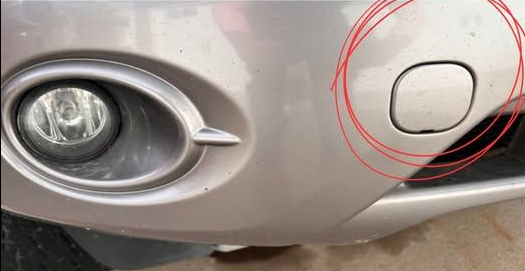Have you ever noticed that small square or rectangular flap on your car’s bumper? At first glance, it might look like nothing more than a design quirk—a subtle detail to break the monotony of smooth metal or plastic. Many drivers never think twice about it, assuming it’s purely cosmetic. But behind that unassuming piece of plastic lies a life-saving feature: the hidden tow hook socket. It’s one of those clever engineering touches that almost no one notices until they really need it.
Why the Panel Exists
Automakers design modern cars with a strong emphasis on aesthetics, aerodynamics, and sleek lines. Exposed hooks or hardware can disrupt that clean look. That’s why the tow hook is often hidden behind a panel that blends seamlessly with the bumper. Unlike large trucks or SUVs, which display hooks openly because they’re designed for heavy-duty use, passenger cars prioritize visual appeal—but without compromising safety. This small flap ensures that even when the hook is hidden, it remains fully functional in emergencies.
When It Can Save You
The hidden tow hook socket is especially useful in real-world situations where a car becomes immobilized. Think about winter mornings when snow piles up unexpectedly, or muddy rural roads that can trap even 4-wheel-drive vehicles. Even a minor mechanical failure in a remote location can leave you stranded, far from help. In these moments, knowing the location and function of your tow hook can make the difference between a simple recovery and a long, stressful wait on the roadside.
Imagine your car slipping off a narrow country road and getting stuck in soft dirt. Attaching a tow strap to a random part of the bumper could cause serious damage—bending, cracking, or even detaching parts of the car. But the hidden tow hook provides a secure, threaded point designed specifically to withstand the force needed to pull a car safely. It’s not just a convenience—it’s a built-in safety feature.
Step-by-Step: How to Use It
Locate the panel: Most cars have a small square or rectangular flap, usually on the front or rear bumper. Check your owner’s manual if you’re unsure; some vehicles have panels at both ends.
Remove the cover carefully: Use your fingers or a flat tool to gently pop it off without damaging the surrounding paint.
Retrieve the tow hook: This is usually stored with your spare tire kit in the trunk or under the cargo area.
Screw in the hook: Align the hook with the threaded hole and twist it in clockwise until firmly seated. Make sure it’s tight to prevent loosening during towing.
Attach the tow strap or cable: Connect your tow line to the hook, ensuring that it’s secure before any pulling begins.
Check and communicate: If someone else is pulling the car, make sure both drivers understand the procedure and communicate clearly to prevent accidents.
Using the tow hook correctly ensures that the force is applied exactly where it’s intended, protecting fragile parts like the bumper, axle, or suspension from damage.
Extra Tips and Considerations
Always check your car’s manual: Different models have different panel locations and hook designs. Knowing this ahead of time saves stress in emergencies.
Practice at home: Even if you never need it, try locating and installing the hook once at home. Familiarity can be a lifesaver if you’re stuck somewhere.
Inspect the hook regularly: Make sure it’s not corroded or damaged. Most hooks are designed to last, but routine inspection ensures readiness.
Replacements are easy: If the panel or hook is missing, replacements are widely available and simple to install. Never improvise by using random parts of the car.
Real-Life Applications
Many drivers have found themselves unexpectedly grateful for this small feature. A commuter trapped in icy conditions in northern states, for example, was able to attach a tow line to the hidden hook and safely be pulled onto a cleared road, avoiding potential collisions. Another driver stuck in mud on a remote trail avoided costly bumper and frame damage simply by using the tow hook.
These examples show that while the panel may seem insignificant, it has a practical, life-saving function that modern drivers often overlook. It’s one of those tiny, thoughtful details that combines engineering ingenuity with safety awareness, quietly waiting to be used only when needed.
Final Thoughts
The next time you walk past your car and notice that small square or rectangular panel, don’t dismiss it. It’s far more than plastic—it’s a built-in escape plan for emergencies, a subtle safety mechanism designed to protect both your vehicle and you. By understanding its purpose and practicing its use, you turn a tiny hidden feature into a powerful tool that ensures peace of mind on the road.
Whether it’s snow, mud, a roadside breakdown, or a simple practice session at home, that little flap represents preparation, safety, and intelligent automotive design. In the world of cars, it proves that even the smallest details can make a big difference when trouble hits the road.
